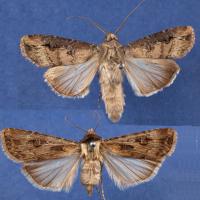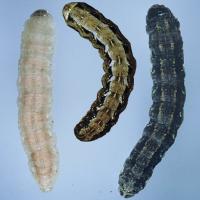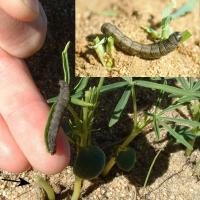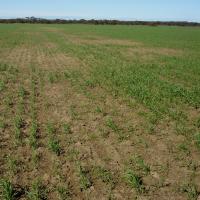Diagnosing cutworm in canola and pulses
Cutworm caterpillars feed on seedling leaves and stems near ground level with stems often chewed through and ‘cut’ to ground level.
What to look for
- Adult cutworms are stout-bodied moths with patterned wings.
Insect Adult
- Caterpillars are up to 50mm long, hairless with a dark head.
- They vary in colour and can be:
Dark grey to green body often with lines and/or dark spots running along length
Pale grey-green body with a pinkish tinge, often with lines and/or dark spots running along length
Orange-brown body with diagonal markings.
Insect Larvae
- Commonly patches with plants that have leaves lopped or are cut off at the base.
Paddock
- Damage is worst at the seedling stage but can persist for several weeks.
- Larvae hide in the soil during the day, often at the base of lopped plants.
Plant
What else could it be
| Condition | Similarities | Differences |
|---|---|---|
| Diagnosing weevils in canola | Chew stem, petiole, leaves and sever the seedling stem | Weevils can cause scalloped leaf damage and have characteristic long snouts. They are usually found in the vicinity of the damage |
| Diagnosing vegetable beetle damage | Chew stem, petiole, leaves and sever the seedling stem | Vegetable beetle are easily found in vicinity of damage |
| Diagnosing false wireworm | Stem ringbarked, sudden plant death | False wireworm ring-bark rather than sever stems |
Where did it come from?
- Cutworm moths can fly large distances and favour bare or lightly vegetated areas for egg laying.
- Moths emerge in late spring or early summer and are often observed entering houses and buildings for shelter over summer. They have one generation per year.
Management strategies
- Cutworm caterpillars usually easily controlled with label rates of synthetic pyrethroid chemicals (refer to currently registered products).
- Early and complete control of green bridge two weeks before planting will minimise survival of cutworm larvae.
Economic and financial considerations
To assist in assessing the economic risk and financial costs associated with various treatment strategies go to MyEconomicTool
There may be other economic and financial implications that need to be considered when choosing a management option. These may include:
Pre-crop- Understand the potential yield losses associated with cutworm feeding damage.
- Assess the costs and benefits of taking preventative action.
- Assess the cost and benefits of controlling summer weeds (green bridge) to reduce potential feed source.
- Compare the costs, benefits and risk of each management option against doing nothing or delaying treatment.
- Ignore all previous treatment costs in assessing current management options.
- Undertake a “what if” scenario analysis to see what impact changing variables, such as grain price and season, have on the net income.
- Consider using integrated pest management system and include a resistance management strategy into your spray program to reduce the chance of cutworm and other non-target insects becoming resistant.
View these economic considerations in more detail.
How can it be monitored?
- Check crops from emergence onwards.
- Larvae are usually just beneath the soil surface during the day and emerge to feed at night.
- Check the base of healthy or recently damaged plants, near bare or thin areas of the crop.
Page last updated: Monday, 1 May 2017 - 12:02pm





